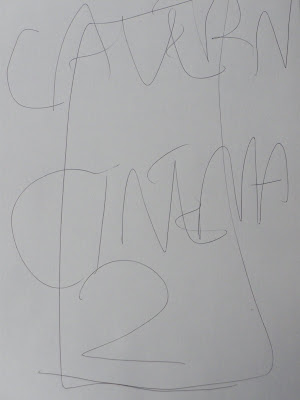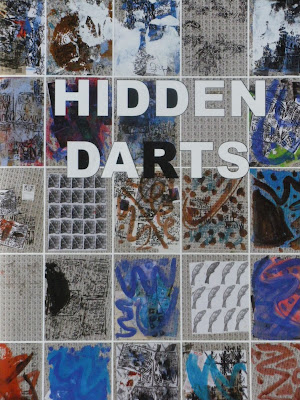
One way of understanding the cavern cinema - particularly with an artist like Smithson, so aware of language - is as a kind of experiential, expanded etymology of the word "underground." If, as other articles here have shown, the word was used to describe a range of directors and film practices, it acquired new force in the writings and performances of Jack Smith, where underground became a remarkable site of paranoia and insult, from which emerged key writings and performances:
Then I was hanging around the uh, the uh, Artcrust Archives. And uh, one day a kindly old man appeared on the steps, and uh, offered me a job as a sugar zombie. And uh, which I uh, accepted. And uh, every day the uh, I and the other sugar zombies would be marched out of the safe into the underground sugar beet pits. No, no, the underground sugar beet, no, no, the underground desert of sugar beets? ...of uh, and we had to toil in the oozing marshmallow paste all day long to harvest these enormous spoiling uh, sugar beets like giant enpurpled Andy Warhol noses... like huge bloated machine-gun turnips that out of the enlarged pores of which would ooze a sugar syrup...and uh... they putrified immediately if you touched them. It was loathsome... loathsome... the foul and purple things... it was hellish. Well, anyway... (coughs)

Long pause with exotic music and tango (137-38)
And then, no lessening of intensity after a break:
I noticed a small pointed doorway that was the uh, doorway to the uh, to Uncle Filmcrust's Hollywood Underground Sugar Hell... (music with jungle noises) Uh, and so uh, I went through this doorway and down some circular stone stairs, and at one end of a giant cavernous vault, I, uh, I saw among the giant boiling uh, uh... what are those things... what? Giant uh, (sighs) - I wish this roach would leave this stage! Please, go away! Shoosh - MEOW - meow, kitty, kitty... giant vats of uh, boiling sugar paste and among those I saw Uncle Artcrust bending over a film duplicating machine. And I realized that this was the reason or the means by which his operation could be understood, and he was duplicating the film left in the safe overnight by anyone he could succeed in having the characteristic two evening engagement of... of.. of uh, the uh, Lucky uh, Landlord Underground, uh, Desert of Blue Glitter. (138)
Smith's artistic transmutation of his disagreements with Jonas Mekas are still hard to read, like camp versions of Artaud's spells and curses. While Artaud gouged violently into sheets of paper, with Smith the emotion explodes into verbal and theatrical fantasy. Mekas' refusal on his trip to London last month to talk about personalities acquires new meaning when one sees how his own figured in Smith's feverish imagination.
How did such vitriol figure within a small community of artists focussed around the Anthology Film Archive? Putting that question aside, the "underground" for Smith is a place where disappointment, bitterness, anger and hate possess a remarkable creative charge. The quotes here are from the script to Smith's 1981 performance What's Underground About Marshmallows?, which had an extended legacy in that the text was also used by Ron Vawter in his 1992 performance Roy Cohn/ Jack Smith. In one example of the transmission of a legacy, Vawter listened to a tape of Smith during his own performance, using it to inform his own timing and inflection.

Juxtapose this conceptualisation of "underground" with Smithson's Cavern Cinema. It suggests both ideas as expressions of creative process as it interacts with issues of career and art world politics. To simplify: Smith's is the unconscious of the idea and Smithson's the conscious, with Smithson's proposal posited on his worldly success as an artist, and Smith's on his sense of struggle, exploitation, and perilous economic plight. Put them together and there is a constantly shifting dialogue between intellectual fulfillment and fury.
Nothing like personal resentment to counter the entropy of the universe. A poem-text on a xeroxed flier further clarified Smith's paranoid and vitriolic views on what really was underground:
Is the underground exotic? No, this is how we got
Hollywood. Unreal film babes unable to do business,
losing money, slave class of loveable landlord class
who irrationally operate theatres in the style of the
passive executive, as just more of the old sacrifice-
betrayal context, the continuing betrayal of the
socialistic impulse.
You know the kind... where we go from co-op, to
distributor to cinematheque to archives...
imperceptibly dissolving from one to the next
incarnation... So he'll never have to go hungry again
like back in Europe.
Welcome through the pointed doorway to the
underground night of Uncle Archives Lucky Landlord
Underground Vaults of Filmcrust! (142-43)
Using all this for an architecture of the cavern cinema, wanting to get away from all that personal venom, but keeping the energy Smith generates, I devised the following group chant:
It's the underground sugar beet pits
and the oozing marshmallow paste
the huge bloated machine gun turnips
from the pores of which a sugar syrup
petrified upon touching. Well anyway
a small doorway the sugar and the tango
down the circular stone steps a giant
cavernous vault and a giant boiling
a duplicating machine how loathsome
uh, of uh, the lucky, uh, blue glitter
dissolving into another incarnation
All quotes in this article are from Wait for Me at the Bottom of the Pool: The Writings of Jack Smith eds. J.Hoberman and Edward Leffingwell (Serpent's Tail, 1997). This is part of an ongoing series of posts unfolding out of the Cavern Cinema proposal of Robert Smithson. Check out the RECENT POSTS listings for other explorations of Smithson's proposal, Stockhausen's cavern concert hall, performance scores, creative etymologies of the underground, photo notations, and C.S.Leigh's memoir of the underground cinema's of Paris.








































